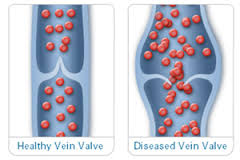Venous Pathophysiology, Part 1:
The North Suburbs of Chicago seems an idyllic place. Great schools. Lovely parks. The beautiful state-of-the-art Rosen Vein Care office in The Professional Plaza at Northbrook Court. But despite all the local trappings and amenities, we live in an imperfect world.
The second year of med school deals with learning about medical imperfection; what happens when things go wrong. Here’s a little taste of 2nd year med school for you…a discussion of venous pathophysiology.
Pathophysiology is why doctors exist. Rosen Vein Care exists to fix the pathophysiology of the superficial venous system. I live and breathe the stuff.
The concept is pretty easy to grasp: remember the major players of the venous system in the lower extremities: veins, valves, and pump…then realize that what can go wrong often does go wrong. The final common pathway of all the problems is an increase in the venous pressure in the extremities (venous hypertension). Let’s consider the players one-by-one:
1. Calf Muscle Pump Failure:
Think of this as “congestive heart failure” of the “peripheral heart”. Decreased pump function→decreased “ejection fraction”(the amount of blood pumped out of the legs and back to the heart)→increased volume of blood remaining in the lower extremities→ INCREASED VENOUS HYPERTENSION. This can be caused by:
–Neuromuscular diseases (can’t move muscles in pump)
–Muscle wasting (used to pump better, now not so much) [Please resist the urge for a “that’s what she said”]
–Deep fasciotomies…or surgical incisions made deep into the muscles that render them unable to be used effectively
2. Plumbing Issues:
Once you start talking about vascular problems what you are really talking about are plumbing issues. Plumbing issues can be boiled down to either blockage/narrowing or leaking. If we used such simplistic terms doctors would never be taken as seriously as they expect to be taken. Therefore we’ve come up with fancy-shmancy ways of saying the same thing. We call blockage “obstruction”. We call the leakage “incompetence”. [If the plumber told us our toilets are obstructed and our faucets are incompetent he’d likely charge us double, G-d forbid]
a) Obstruction: The pump is fine but it can’t get blood past a blockage. Think about:
-clots (call them thrombi to sound fancier still)
-external pressure from swelling, local masses,etc.
b) Incompetence: The pump & “pipes” are fine, but the one-way valves within the pipes are leaky and allow blood to flow back downward into the legs.
-Primary problem: if you weren’t born with valves or the ones you were born with are ineffectual
-Secondary: damage to valves due to
-previous clot
-direct trauma
-dilitation of veins→valve cusps can’t touch to create a good seal
…all of these things can lead to decreased blood moving out of the lower extremities→ Increased Venous Hypertension
3. Plumbing Issues: Perforator Vein Problems
Ordinarily flow goes from superficial veins to deep via perforators. In this case, flow reverses from deep to superficial→ higher pressure is transmitted to weaker superficial vessels→ Increased Venous Hypertension in superficial vessels.
4. Plumbing Issues: Superficial Venous Incompetence (Insufficiency)
This is the most common form of venous disease and can be due to:
a) Primary valve failure due to
-direct injury
-inflammatory conditions: such as infection or vasculitis
-superficial thrombophlebitis: many patients suffering from varicose veins have dealt with inflamed clot-filled veins. Are you sensing another vicious circle? Yes, thrombophlebitis in turn can cause valves to malfunction which can lead to worsening varicosities and on & on…until you and Rosen Vein Care do something about it, that is!
b) Secondary valve failure:
-Congenital: weak veins with abnormal valves→veins dilate→ valve cusps don’t meet in the midline
-Hormone exposure: causes smooth muscle relaxation→ vein walls get too “stretchy”→dilitation of veins→ cusps don’t meet
-Especially during pregnancy
-Also likely why symptoms are worse during menses
So…no matter what factors led to this point. Once there is decreased blood out of the legs→more blood stays behind→ hydrostatic pressure builds up→INCREASED VENOUS HYPERTENSION…which ultimately leads to:
–Failure of valves→reflux “upstream”→perpetuates disease
–Failure of walls→veins become tortuous/dilated→ Varicose Veins (a relatively early manifestation of disease)
–Skin changes: a late and possibly irreversible problem due to chronic inflammation
Here’s a look at what reflux looks like in action:
Well…now we know what happens in the tumultuous course of venous disease that ultimately leads to venous hypertension. After that it is anyone’s guess as to exactly how things play out that leads to varicose/spider veins and skin changes. However, over time, the guesses have been getting better.
Stay tuned to the next episode when Dr. Dave will discuss Theories Old & New.
Meanwhile if you seek answers to your specific vein questions…if you seek refuge from the harsh wasteland of venous imperfection…stop by our little oasis in Northbrook. Call 847-272-8346 to schedule an initial consultation. I can’t promise palm trees and margaritas, but we serve up fresh perspective and sunny dispositions.

